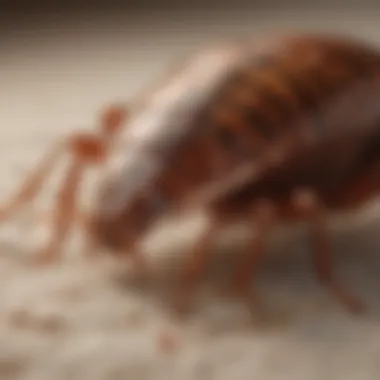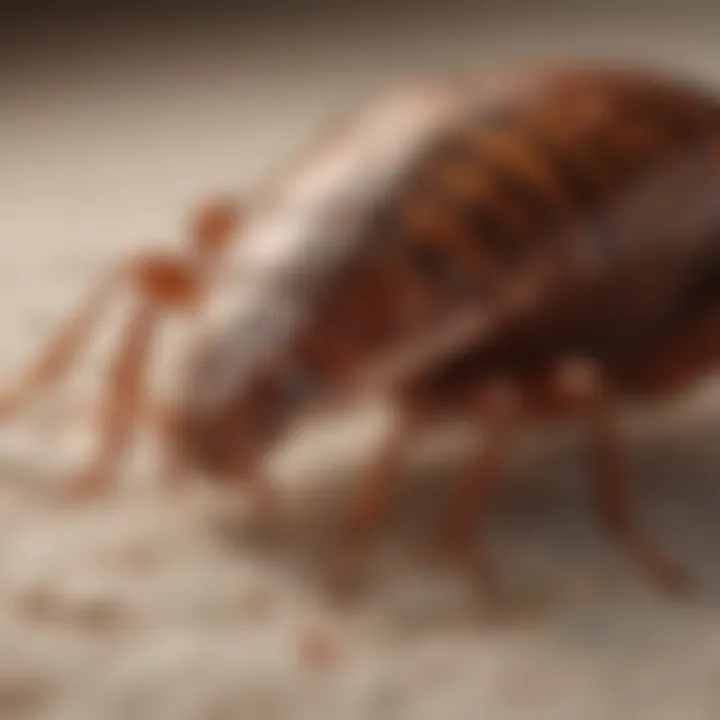Understanding Bed Bugs in Denver: A Comprehensive Guide


Intro
Bed bugs have become quite the chatter these days, especially in bustling cities like Denver. These tiny pests can wreak havoc in homes if left unchecked. It’s essential for both homeowners and renters to have a good grasp on how to identify, prevent, and tackle bed bug infestations effectively. With the right knowledge, you can arm yourself against these unwelcome guests.
Pest Identification
Identifying bed bugs is the first line of defense in your fight against them. These critters are small, brownish, and can easily hide in cracks and crevices. It helps to know what you’re looking for:
Detailed descriptions of common pests
Bed bugs, Cimex lectularius, resemble flat, brownish apple seeds. Adults are about a quarter inch long, and the young ones (nymphs) are even smaller with more transparency, making them harder to spot. Their bodies swell with blood after feeding, turning a deep red.
Signs and symptoms of infestations
If you suspect you have bed bugs, keep an eye out for these signs:
- Bite marks: Red, itchy welts often appear on parts of the body that come into contact with the bed or furniture.
- Dark stains: You may notice small, dark spots on sheets or mattresses, which are often bed bug droppings.
- Eggs or shed skins: Tiny, white eggs and molted skins can also be indicators of a growing infestation.
"Proactive identification is key to preventing a small problem from becoming a big headache."
Prevention Strategies
Bed bug infestations are often a result of improper preventative measures. Taking the following steps can safeguard your home:
Home maintenance tips for pest prevention
- Regularly vacuum your home, particularly around bed frames and baseboards.
- Seal up cracks and openings in walls, floors, and furniture to eliminate hiding spots.
- Wash bedding and clothing in hot water often to kill any possible eggs or bugs.
Natural deterrents and barriers
There are several natural solutions that can deter bed bugs:
- Essential oils like lavender and tea tree oil are known to repel these pests.
- Diatomaceous earth, when sprinkled around potential entry points, can be a formidable barrier for bed bugs.
Treatment Options
When it comes to treatment, knowing your options makes a world of difference. You generally have two paths to choose from:
Overview of chemical vs. natural treatments
Chemical treatments might provide a quicker resolution but come with their own set of health concerns. In contrast, natural treatments can be safer but may require more effort and time to yield results.
Step-by-step guides for DIY treatments
If you’re inclined to tackle the problem yourself, consider these methods:
- Vacuum thoroughly: After vacuuming, dispose of the bag or canister contents in an outdoor trash bin.
- Apply diatomaceous earth: Lightly dust it in areas where you believe bed bugs may enter or reside. Leave for a few days, then vacuum again.
- Steam cleaning: Utilizing a steam cleaner on fabrics such as mattresses and upholstery can kill bed bugs on contact.
By understanding these aspects of bed bugs, you’ve taken the first crucial step toward regaining control of your home. Knowledge is power, and with this guide, you're better equipped to prevent and address bed bug issues effectively.
Prolusion to Bed Bugs
Bed bugs, those tiny, pesky critters, have made quite a name for themselves as a significant nuisance in homes across Denver. While they may not pack a punch like some pests, their ability to spread rapidly and develop resistance to treatments creates a challenge for homeowners and renters alike. Understanding these pests is essential, especially in urban environments like Denver where people frequently come and go, potentially bringing these unwelcome guests with them.
Definition and Overview
Bed bugs are small, flat, and reddish-brown insects that feed on the blood of humans and other animals. They typically measure about 4 to 5 millimeters in length, making them small enough to hide in various nooks and crannies. Their flattened bodies allow them to squeeze into spaces as thin as a credit card. Unlike some insects, bed bugs do not fly, but they are agile crawlers and can easily travel from one location to another by attaching themselves to clothing or luggage. The scientific name for the common bed bug is Cimex lectularius.
In recent years, the issue of bed bugs has resurged, leading to increasing discussions about how to effectively control their presence. People often overlook bed bugs due to their elusive nature and the misconceptions surrounding their behavior. It's crucial to dispel these myths and provide accurate information to those who might be facing or trying to prevent an infestation.


The Importance of Addressing Bed Bug Issues
Ignoring an infestation can lead to a bigger problem, not just in terms of discomfort—itchy bites, sleepless nights—but also the financial burden associated with extensive pest control efforts. Once bed bugs establish themselves in a home, they multiplied quickly, making it an uphill battle for homeowners trying to rid themselves of these pests.
Furthermore, addressing the issue promptly can prevent potential transfer to neighboring residences, which is especially critical in multifamily buildings prevalent in Denver. This communal aspect underscores the necessity for every individual to be proactive.
"A stitch in time saves nine"—acting promptly on bed bug sightings can prevent a minor issue from spiraling into a full-blown infestation.
Bed Bug Species and Identification
The identification of bed bug species plays a critical role in effectively managing infestations. Recognizing the various types of bed bugs can help homeowners and renters in Denver understand the nature of their problem and determine the most suitable strategies for control and prevention. Not only does identification help in confirming the presence of these pests, but it also aids in tailoring specific treatment options that correspond to a particular species’ behavior and resistance to various extermination methods. The more informed you are about what you’re dealing with, the better equipped you become to combat the issue head-on.
Common Bed Bug Species in Denver
In Denver, the most common bed bug species is the Cimex lectularius, also known as the common bed bug. These bugs are notorious for their ability to hitch a ride on luggage, clothing, or even secondhand furniture, making them challenging to eliminate once they find their way into a home.
- Cimex lectularius: The most prevalent species, adapted to living in human environments, often found in mattresses, bedding, and furniture.
- Cimex hemipterus: Less common than its cousin, this species tends to prefer warmer climates but can occasionally be found in Denver.
Recognizing the differences can offer insight regarding potential treatment effectiveness, as some species might be resistant to certain remedies. Hence, understanding local species is important for strategic intervention.
Visual Identification Techniques
Identifying bed bugs can often feel like searching for a needle in a haystack, but knowing what to look for can make the process smoother. Here are some key attributes to focus on:
- Size and Shape: Adult bed bugs are typically about the size of an apple seed—around 4-5 mm long—flat and oval-shaped. Newly hatched nymphs are much smaller and may be more difficult to spot.
- Coloration: They can range from a whitish hue when first hatched to reddish-brown as adults. Their color can be an important factor when determining their presence, especially during different life stages.
- Visible Excrement: Look for small, dark spots on mattress seams or bed frames. These are often bed bug droppings and can provide clear evidence of their existence.
An effective method is to use a flashlight to inspect your sleeping area at night, when these pests are most active.
Signs of Infestation
Awareness of the signs of bed bug infestations can save a lot of hassle and potentially costly treatments down the line. Here are some indicators:
- Bite Marks: While not everyone reacts to bed bug bites, they often appear as small, red welts in a cluster or line on the skin, commonly waking up with itchy spots may suggest an infestation.
- Shed Skins: Bed bugs molt as they grow, leaving behind their exoskeletons. Finding these discarded shells is a strong indicator of an active infestation.
- Bloodstains: Small blood spots on sheets or mattress, often from crushed bed bugs after a feed.
"Quickly identifying the signs of bed bug infestations can prevent the situation from worsening and safeguard your home from this alarming problem."
Being vigilant and knowledgeable about these signs helps maintain a pest-free home and assists in prompt action should the need arise.
Causes of Bed Bug Infestations
Understanding the causes of bed bug infestations is the first step in effectively combating these pesky intruders. In this section, we will examine both environmental factors unique to Denver and the human behaviors that contribute to the proliferation of bed bugs. By grasping these causes, homeowners and renters can better implement strategies to prevent and manage infestations in their own spaces.
Environmental Factors in Denver
The rocky terrain and diverse climate of Denver create a unique environment that can unintentionally support bed bug populations. For instance, the city’s housing stock includes numerous older buildings where these pests find refuge. The cracks and crevices in older structures provide a perfect hiding spot for bed bugs. Moreover, the fluctuating temperatures in Denver can also affect bed bug activity. In colder months, many residents crank up the heat, inadvertently creating a warm environment that bed bugs love to thrive in.
Some other environmental factors to consider include:
- High Population Density: As a bustling city, Denver sees a high level of movement in and out of homes and apartments. This constant turnover allows bed bugs to hitch rides on personal belongings or even in luggage.
- Tourism and Hotel Stays: With a growing tourism sector, many travelers book accommodations in local hotels or short-term rentals, increasing the chance of bed bug introductions. Guests who unknowingly carry bed bugs in their luggage can leave behind an infestation for others to deal with.
It's essential to keep such factors in mind when evaluating risk in your home. By recognizing that bed bugs are adept at adapting to urban settings, residents can take proactive steps to minimize exposure and identify potential nesting sites more effectively.
Human Behavior as a Contributing Factor
While environmental aspects play a significant role in the spread of bed bugs, human behavior is equally crucial. Many habits that people might not consider problematic can inadvertently lead to infestations. Education is key in unraveling these behaviors that allow bed bugs to thrive.
Some notable human behavior factors include:
- Neglecting Regular Inspections: Many people don’t think to inspect their homes regularly for signs of bed bugs. If someone moves into a new place or returns from a trip without a thorough examination, they might unwittingly bring these pests home.
- Second-hand Furniture: Buying or acquiring used furniture can be a double-edged sword. While it's often a budget-friendly option, this practice can also introduce bed bugs into a home if the items have not been properly checked beforehand.
- Poor Hygiene Practices: In some cases, people may overlook basic cleaning tasks like washing linens or vacuuming frequently. Maintaining a clean environment should not be brushed off, as a tidy space can deter bed bugs from finding a suitable hiding spot.
To sum it up, a better understanding of the behavioral aspects combined with environmental factors can provide critical insights into preventing bed bugs. Homeowners and renters alike can benefit from being mindful of these factors, leading to smarter choices that help reduce the risk of infestations in their homes.


Prevention Strategies for Homeowners
When dealing with the possibility of bed bug infestations, homeowners must adopt a proactive mindset. Prevention is much less burdensome than treatment after an infestation has taken root. It’s about staying a step ahead, and that can not only save money but also protect your living space from becoming a breeding ground for these unwelcome guests. Implementing effective prevention strategies makes a huge difference in keeping these pint-sized nuisances at bay.
Routine Inspections
One of the bedrocks of prevention is establishing a regimen of routine inspections. Homeowners should routinely check sleeping areas, furniture, and even baseboards for any early signs of bed bugs. Inspecting seams of mattresses, folds of comforters, and the sides of nightstands can reveal pests before they can multiply.
In Denver, with changing seasons and increased travel, vigilance is crucial. During warmer months, when travel often increases, it’s wise to inspect after returning home.
- When inspecting, look for:
- Dark spots on surfaces, which could be bed bug droppings.
- Shed skins, which indicate growth and reproduction.
- Live bugs hiding in crevices.
By making these inspections a part of your regular cleaning schedule, homeowners can significantly reduce their chances of an infestation.
Effective Cleaning Practices
Cleaning practices play a pivotal role in prevention. It’s not just about aesthetics; it’s about sanitation and vigilance. Regularly vacuuming carpets, upholstery, and even mattresses can help identify and remove any stray bed bugs that may have made their way into your home. More importantly, washing bedding and other fabric items in high heat can eliminate any potential bed bugs or eggs lurking in household textiles.
- Here are steps to enhance cleaning effectiveness:
- Use a vacuum: Ensure you use a vacuum with strong suction and consider a crevice tool to reach tight spots.
- Wash and dry: Items like bedding should be washed in hot water and dried on a hot cycle. Heat is lethal to bed bugs at all life stages.
- Frequent dusting: Don’t just rely on the vacuum; dust surfaces regularly to minimize places where bed bugs can take shelter.
By integrating these practices, you create a less hospitable environment for bed bugs, discouraging them effectively.
Travel Precautions
Traveling can often be a means of bringing bed bugs right into your home. It’s essential to stay aware of potential risks when you check into a hotel or Airbnb. Ignoring these risks can lead to unwittingly hosting bed bugs.
- To safeguard yourself when traveling:
- Inspect accommodations: Before settling in, inspect the bed and surrounding areas for any evidence of bed bugs.
- Keep luggage elevated: Avoid placing items directly on the floor or bed. Use luggage racks or place bags on metal frames.
- Wash before returning home: Upon returning, wash all clothes—even those that didn’t leave your suitcase. This ensures that any stray bugs are dealt with before they can breed.
Taking travel precautions means you’ll need to be alert and attentive, but it goes a long way in reducing the chance of an infestation.
In summary, establishing a vigilant routine through inspections, effective cleaning practices, and travel precautions creates a robust defense against bed bugs.
By staying proactive, homeowners cover all bases and help ensure their living spaces are free from these unwanted intruders.
Treatment Options for Infestations
Dealing with bed bug infestations can feel like fighting a small but persistent war in your home. The presence of these uninvited guests isn't merely about discomfort but also about the potential health risks they pose. Treatment options are crucial in managing these pests effectively, as the choice of treatment can significantly influence not only the outcome but also the time and resources required for elimination. It's important to understand the various approaches available, their effectiveness, and any potential side effects.
Chemical Treatments
Chemical treatments remain one of the most common solutions for bed bug infestations. Here's a deeper look:
- Types of Chemicals: The term 'chemical treatments' often brings to mind harsh products. However, there is a range of options, from pyrethroids to neonicotinoids and even insect growth regulators (IGRs). Each type works differently, and understanding their modes of action can help homeowners make informed choices.
- Advantages: One significant benefit of chemical treatments is their fast action. Many formulations can kill bed bugs on contact, providing immediate relief to the affected area. Additionally, some chemicals provide residual effects, meaning they can continue to eliminate bugs for weeks after application, tackling newly hatched pests as they emerge.
- Considerations: However, relying solely on chemicals is not recommended. Bed bugs can develop resistance over time to certain pesticides, rendering them ineffective. As such, it's critical to rotate the chemicals used and always follow label instructions carefully to avoid potential health hazards to humans and pets.
"Chemical treatments can quickly eliminate visible pests, but always consider a multifaceted strategy for a lasting solution."
Heat Treatment Solutions
Heat treatment is an eco-friendly and chemical-free approach gaining traction among homeowners for dealing with bed bugs. This method involves raising the temperature in the infested area to a lethal level for bed bugs—generally around 120°F (49°C).
- Effectiveness: Heat is effective because it penetrates materials like mattresses and furniture, reaching bugs hidden deep within. Unlike chemicals, which may leave some eggs behind, heat kills all life stages, including eggs, effectively breaking the cycle of infestation.
- Process: A professional pest control service typically performs heat treatments, using specialized equipment to ensure uniform heating throughout the area. They also monitor temperatures to avoid damage to belongings.
- Challenges: While effective, this method can be costly and time-consuming. Homeowners must be prepared to vacate their homes during treatment, as safety protocols require leaving the property for several hours until temperatures return to normal.
Integrated Pest Management Techniques


Integrated Pest Management (IPM) is an increasingly favored approach to combat bed bugs, combining various strategies for more sustainable pest control.
- Holistic Approach: IPM encompasses preventive measures, monitoring, and using different treatment methods in tandem. For example, a combination of chemical treatments and heat solutions, along with thorough cleaning and home maintenance, can yield better results than any method alone.
- Non-Chemical Tactics: Simple actions like sealing cracks in walls, using bed bug-proof covers on mattresses, and regular vacuuming can keep infestations at bay. It’s about making your home less hospitable to these pests.
- Ongoing Monitoring: A crucial part of IPM is consistent monitoring for signs of bugs post-treatment to ensure that any resurgence is immediately addressed.
Myths and Misconceptions About Bed Bugs
When it comes to battling bed bugs, jumping to conclusions can do more harm than good. This section highlights the importance of addressing the myths and misconceptions surrounding these pests. Understanding the truth is crucial, not just for reducing stigma, but also for forming effective management strategies. Often, individuals face shame or embarrassment upon discovering a bed bug problem, believing it signifies poor hygiene or a guilty conscience. The reality is that bed bugs are not picky; they latch onto anyone, regardless of their living conditions. By debunking these myths, we can equip homeowners with the right information, which serves as the first defense against infestations.
Myths Surrounding Transmission
A common belief is that bed bugs spread quickly through direct contact with other people, much like lice. While it's true that bed bugs can hitch a ride on clothing or bags, their primary mode of travel involves moving between infested and non-infested spaces. Bed bugs prefer to hide in the seams of luggage, clothing, and even furniture. If someone sleeps in an infested bed or brings second-hand items into their home, that increases the chances of transmitting these pests. Here are several crucial points to consider:
- They aren't a reflection of your cleanliness. Bed bugs are equal opportunity pests; they don't discriminate based on how tidy your home is.
- Not all bites lead to infestation. A single encounter doesn’t guarantee you'll have a full-blown problem, though vigilance is necessary.
- They can be found anywhere. Hotels, schools, and public transport are notorious for harboring these unwelcome travelers.
"Bed bugs are like the uninvited guests who just won't leave; they come for the feast but know how to stay hidden."
Understanding how transmission works can help in preventing infestations. Avoid assumptions, and focus on prevention.
Misunderstanding Bed Bug Behavior
Many people misinterpret the behavior of bed bugs, adding to the level of anxiety surrounding these pests. One prevalent myth is that bed bugs are only active at night. While they do prefer to feed when their hosts are asleep, they can be active at any time of the day if they feel hungry. Here are some misconceptions:
- They can’t survive outside of homes. The truth is, bed bugs can thrive in various settings, sometimes moving into hotels or motels if they find a hospitable environment.
- Only dirty homes get bed bugs. This has been mentioned before but bears repeating: bed bugs don’t care about cleanliness. It’s about the availability of hosts for feeding.
- DIY methods always work. While some may report success using household remedies, improper or half-hearted efforts often lead to future infestations.
Understanding bed bug behavior is essential to take appropriate actions and dispel myths that hinder effective responses.
Resources for Further Assistance
When it comes to tackling the persistent problem of bed bugs in Denver, having the right resources at hand is absolutely crucial. This aspect not only provides you with a safety net but also empowers you with knowledge and tools designed to combat these pesky critters. Whether you’re a homeowner looking for effective ways to manage an infestation, or simply want to arm yourself with information to prevent one, understanding where to turn for help can make all the difference.
Professional Pest Control Services in Denver
Engaging the services of a professional pest control expert often proves to be a wise decision. Pest control companies offer specialized knowledge and resources that an average homeowner may lack. These professionals not only identify the scope of the infestation accurately but also come equipped with advanced tools and eco-friendly treatment solutions to eradicate bed bugs effectively.
- Expertise: They are trained to recognize the signs of bed bugs, even when they are hard to spot.
- Safety: Many services employ methods that minimize exposure to chemicals, keeping your home safe, especially if children or pets are present.
- Time-efficient: Hiring a service frees up your schedule, allowing you to focus on other essential aspects of your life.
However, it’s vital to do your homework before selecting a pest control service. Ensure they are licensed and insured, and read reviews from other customers to gauge their effectiveness. Just because it seems like a good deal does not mean the service is high-quality—sometimes you get what you pay for.
"A stitch in time saves nine," especially when it comes to tackling bed bugs early with professional help.
Support Groups and Online Communities
Finding a community that understands the painstaking struggle with bed bugs can provide emotional support and practical advice. Online platforms like Facebook groups, Reddit forums, and even specialized sites are filled with individuals sharing their stories, solutions, and tips. These communities offer not only practical guidance but also a sense of camaraderie that can be reassuring.
- Shared Experiences: Hearing about what others have gone through can give you insight into what to expect and how to cope.
- Advice and Tips: Many members share effective DIY treatments and preventive measures that have worked for them, which can save you both time and money.
- Moral Support: The often embarrassing nature of dealing with bed bugs can lead to feelings of isolation; finding a community where this is a common issue can help you feel less alone.
In these groups, remember to sift through the advice critically. What works for one person might not fit your unique situation, and not all advice can be considered safe or effective. Stay vigilant and continue to seek professional guidance when necessary.
End and Key Takeaways
Navigating the challenging waters of bed bug infestations can feel like a daunting task, especially for homeowners and families in Denver. The importance of addressing bed bug issues can't be overstressed, as these tiny creatures can wreak havoc not just in your home but also in your personal peace of mind.
Throughout this guide, we have explored various critical aspects surrounding bed bugs. From understanding their species and identifying signs of infestation, to discussing prevention strategies and treatment options, each section offers a comprehensive toolkit for tackling this persistent pest problem. The knowledge gained here is not just academic; it's practical and applicable in real-world scenarios. It empowers you to take action before bed bugs turn your home into a battleground.
Addressing bed bug problems head-on involves not only immediate actions—like opting for professional pest control—but also long-term strategies such as routine inspections and effective cleaning practices. Learning to recognize the signs of potential infestations quickly can make all the difference. The sooner you act, the easier it is to manage the situation.
A key takeaway from this guide is to foster an environment where prevention becomes second nature. This is especially vital in a city like Denver, where the conditions can facilitate bed bug populations. In addition to implementing preventive measures, integrating knowledge from local communities can be invaluable, as shared experiences often bring insights that you wouldn’t find in a manual.
"An ounce of prevention is worth a pound of cure."
Summarizing Best Practices
To wrap things up, let's highlight some best practices for combating bed bug infestations:
- Routine Inspections: Regularly check key areas in your home, especially around the bed and furniture.
- Effective Cleaning Practices: Washing linens in hot water and vacuuming thoroughly can aid in prevention.
- Travel Precautions: Always inspect luggage after traveling and avoid bringing used items from unknown sources into your home.
These points summarize a proactive approach to managing and, hopefully, preventing bed bug issues. Remember, while the inital actions might take effort, the rewards of a bed bug-free home are undeniably worth it.



